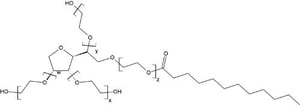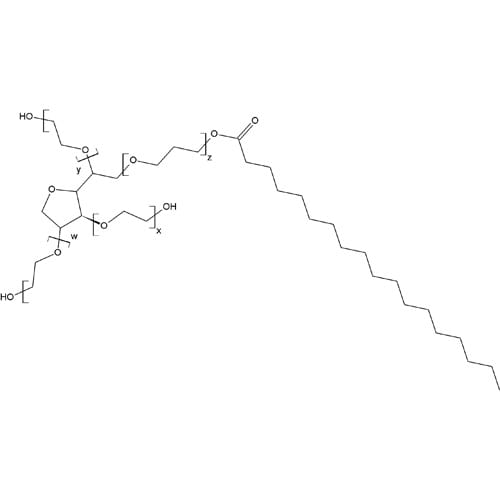As a non-ionic viscous liquid, tweens are a class of emulsifiers used in pharmaceuticals and food preparation.
Tween® 20 and Tween® 80 are both biocompatible surfactants used in food, biotechnical, and pharmaceutical applications. However, despite their similar uses, there are differences between the two types of tweens.
What is Tween®?
Otherwise known as polysorbates, tweens are typically used as a surfactant for dispersing hydrophobic particles in aqueous solutions, as well as a non-ionic detergent for selective protein extraction and isolation of nuclei from mammalian cells.
Tweens are a condensate of sorbitol fatty acid ester and ethylene oxide, and either soluble or dispersible in water but differ widely in organic and oil solubilities.
What is Tween® 20?
 Tween® 20, or Polysorbate 20, is a popular choice for biochemical applications. With a hydrophobic dodecanoic tail, it attached to 20 repeat units of polyethylene glycol and distributed across four different chains.
Tween® 20, or Polysorbate 20, is a popular choice for biochemical applications. With a hydrophobic dodecanoic tail, it attached to 20 repeat units of polyethylene glycol and distributed across four different chains.
As a non-ionic surfactant, Polysorbate 20 has a molecular weight of 1,225 daltons, assuming 20 ethylene oxide units, one sorbitol, and one lauric acid as the primary fatty acid.
The ethylene oxide subunits are responsible for the hydrophilic nature of the surfactant, while the hydrocarbon chains provide the hydrophobic environment. Ethylene oxide polymers attach to the backbone ring, which is formed by sorbitol.
It is also miscible in water (100 mg/ml) and yields a clear, yellow solution. It is practically insoluble in liquid paraffin and fixed oils, and also miscible in alcohol, dioxane, and ethyl acetate.
What is Tween® 80?
 Tween® 80 is a non-ionic detergent for solubilizing membrane proteins during the isolation of membrane-protein complexes, and is available with ultra-low concentrations of contaminating peroxides, aldehydes, salts, and carbonyl compounds.
Tween® 80 is a non-ionic detergent for solubilizing membrane proteins during the isolation of membrane-protein complexes, and is available with ultra-low concentrations of contaminating peroxides, aldehydes, salts, and carbonyl compounds.
Tween 80 is also a polyethylene sorbitol ester, otherwise known as Polysorbate 80 or polyoxyethylene sorbitan monooleate. It has a molecular weight of 1.31 kDa and works well as a stabilizer and emulsifier, primarily in cosmetics, pharmaceuticals, and food products.
Tween 80 is also miscible in water (0.1 ml/ml) and yields a clear, yellow solution. It is also miscible with alcohol, dioxane, and ethyl acetate, and is practically insoluble in liquid paraffin and fixed oils.
What is the Difference Between Tween 20 and Tween 80?
Tween 20 and Tween 80 are both used in food, biotechnical, and pharmaceutical applications. However, they are present in different types of applications.
Tween 20 is a common component in the following applications:
- The pre-extraction of membranes to remove peripheral proteins
- Membrane-based immunoassays
- Lysing mammalian cells
- PCR (polymerase chain reaction)
- ELISA (enzyme-linked immunosorbent assay)
- Western blot analysis
Due to its drying property, Tween 80 is typically present in ice cream. It is also widely utilized in biochemical applications, including:
- Isolating nuclei from mammalian cell lines
- Growing of tubercle bacilli
- Selective protein extraction
- Emulsifying and dispersing substances in medicinal and food products
- As a hydrophilic emulsifier in the preparation of W1/O/W2 emulsion
Choose G-Biosciences for Your Tween 20 and Tween 80 Needs
G-Biosciences offers a variety of products and supplies for your biochemical and life science experiments, including research-grade Tween 20 and Tween 80. Visit our website to claim yours today!




-500x500.jpg)

